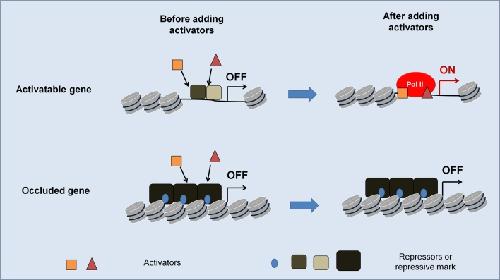XB-IMG-129062
Xenbase Image ID: 129062

|
|
Fig. 1. Silenced genes can be classified into two categories (activatable and occluded genes) depending on the resistance to transcriptional activation. After the addition of transcriptional activators, some of the previously silenced genes can start transcription (activatable genes). Silencing of such genes is likely due to the absence of activators and/or the presence of repressors and hence addition of activators allows transcriptional activation from those genes. In other words, activators have access to those genes to induce gene activation. In contrast, some genes are not activated even if known activators of these genes are present (occluded genes). This is probably because occluded genes are silenced by chromatin-based mechanisms that preclude access of activators to target genes. It seems to take a longer time for activators to finally gain access to such genes. This classification of genes in response to transcriptional activators has been proposed by Lahn and colleagues [26, 27]. Activation from occluded genes can be enhanced by adding chromatin remodeling factors and chromatin modifiers that can relieve these chromatin-based repression mechanisms Image published in: Miyamoto K and Gurdon JB (2013) © The Author(s) 2012. Creative Commons Attribution license Larger Image Printer Friendly View |
